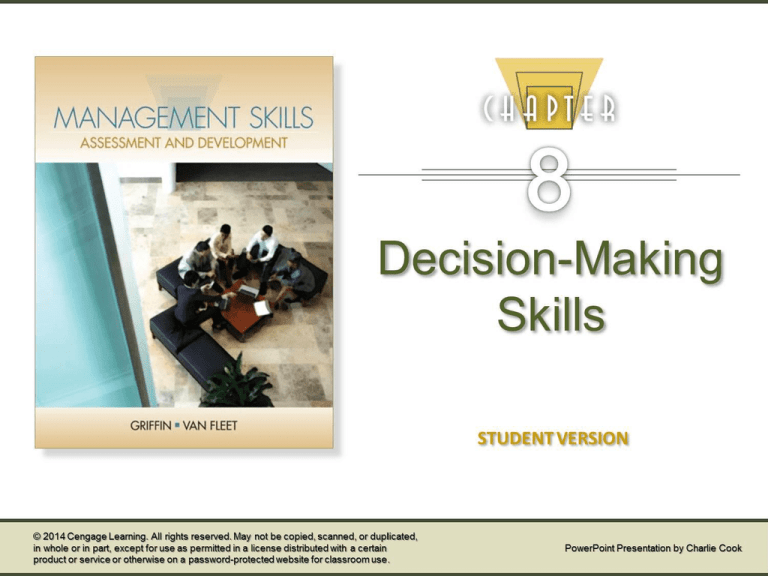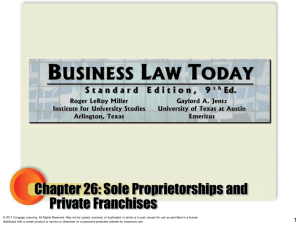
The Decision-Making Context
• Decision Making
– The act of choosing one alternative
from among a set of alternatives.
• Decision-Making Process:
Recognizing
and defining
the decision
situation
Identifying
alternatives
Choosing
the “best”
alternative
© 2014 Cengage Learning. All rights reserved. May not be copied, scanned, or duplicated, in whole or in part, except for use as
permitted in a license distributed with a certain product or service or otherwise on a password-protected website for classroom use.
Putting the
alternative
into practice
8–2
Types of Decisions
• Programmed Decision
– is a relatively structured decision or one
that recurs with some frequency (or both).
• Example: Starting your car in the morning.
• Nonprogrammed Decision
– is relatively unstructured and occurs much
less often a programmed decision.
• Example: Choosing a vacation destination.
© 2014 Cengage Learning. All rights reserved. May not be copied, scanned, or duplicated, in whole or in part, except for use as
permitted in a license distributed with a certain product or service or otherwise on a password-protected website for classroom use.
8–3
Conditions for Making Decisions
Conditions Affecting
Decision Making
Decision Making
Under
Certainty
Decision Making
Under
Risk
Decision Making
Under
Uncertainty
© 2014 Cengage Learning. All rights reserved. May not be copied, scanned, or duplicated, in whole or in part, except for use as
permitted in a license distributed with a certain product or service or otherwise on a password-protected website for classroom use.
8–4
Rational Decision Making
• The Rational Model Assumes:
1. Decision makers have complete information about
the decision situation and possible alternatives.
2. Decision makers can effectively eliminate
uncertainty to achieve a decision condition of
certainty.
3. Decision makers evaluate all aspects of the
decision situation logically and rationally.
© 2014 Cengage Learning. All rights reserved. May not be copied, scanned, or duplicated, in whole or in part, except for use as
permitted in a license distributed with a certain product or service or otherwise on a password-protected website for classroom use.
8–5
Steps in the Rational Decision-Making Process
Step
Detail
1. Recognizing and defining the
decision situation
Some stimulus indicates that a decision must be
made. The stimulus may be positive or negative.
2. Identifying alternatives
Both obvious and creative alternatives are desired.
In general, the more important the decision, the
more alternatives should be generated.
3. Evaluating alternatives
Each alternative is evaluated to determine its
feasibility, its satisfactoriness, and its
consequences.
4. Selecting the best alternative
Consider all situational factors and choose the
alternative that best fits the manager’s situation.
5. Implementing the chosen
alternative
The chosen alternative is implemented into the
organizational system.
6. Following up and evaluating
the results
At some time in the future, the manager should
ascertain the extent to which the alternative
chosen in step 4 and implemented in step 5 has
worked.
© 2014 Cengage Learning. All rights reserved. May not be copied, scanned, or duplicated, in whole or in part, except for use as
permitted in a license distributed with a certain product or service or otherwise on a password-protected website for classroom use.
8–6
Selecting an Alternative
Optimization of
Individual Alternatives
Feasibility?
Satisfactoriness?
Consequences?
© 2014 Cengage Learning. All rights reserved. May not be copied, scanned, or duplicated, in whole or in part, except for use as
permitted in a license distributed with a certain product or service or otherwise on a password-protected website for classroom use.
8–7
Implementing an Alternative
Issues in the Implementation
of the Selected Alternative
Integration into
current processes
Resistance by
employees
© 2014 Cengage Learning. All rights reserved. May not be copied, scanned, or duplicated, in whole or in part, except for use as
permitted in a license distributed with a certain product or service or otherwise on a password-protected website for classroom use.
Unanticipated
consequences
8–8
Following Up and Evaluating the Results
• Evaluate the effectiveness of the alternative:
– Did the chosen alternative serve its purpose?
– Has it had time to prove its effectiveness?
• If chosen alternative is not working:
– Discard the original implementation decision and
implement another previously identified alternative
– Restart alternative search and decision process
© 2014 Cengage Learning. All rights reserved. May not be copied, scanned, or duplicated, in whole or in part, except for use as
permitted in a license distributed with a certain product or service or otherwise on a password-protected website for classroom use.
8–9
The Administrative Model
of Decision Making
When faced with a
decision situation,
managers
actually…
• use incomplete and
imperfect information
• are constrained by
bounded rationality
• tend to “satisfice”
…and end up with
a decision that may
or may not serve
the interests of the
organization
© 2014 Cengage Learning. All rights reserved. May not be copied, scanned, or duplicated, in whole or in part, except for use as
permitted in a license distributed with a certain product or service or otherwise on a password-protected website for classroom use.
8–10
Behavioral Processes and Decision Making
Bounded
rationality
Satisficing
Intuition
Influences on
Decision
Making
Coalitions
© 2014 Cengage Learning. All rights reserved. May not be copied, scanned, or duplicated, in whole or in part, except for use as
permitted in a license distributed with a certain product or service or otherwise on a password-protected website for classroom use.
Escalation of
commitment
Risk
propensity
8–11
Ethics and Decision Making
Employees
Individual
Ethics
Managerial
Ethics
Organizational
Ethics
Other economic agents
© 2014 Cengage Learning. All rights reserved. May not be copied, scanned, or duplicated, in whole or in part, except for use as
permitted in a license distributed with a certain product or service or otherwise on a password-protected website for classroom use.
8–12
Ethics and Decision Making
• Managerial Ethics
– Individual ethics (personal beliefs about right and
wrong behavior) combine with the organization’s
ethics to create managerial ethics.
• Components of Managerial Ethics:
– Relationship of the firm to employees
– Employees to the firm
– The firm to other economic agents
© 2014 Cengage Learning. All rights reserved. May not be copied, scanned, or duplicated, in whole or in part, except for use as
permitted in a license distributed with a certain product or service or otherwise on a password-protected website for classroom use.
8–13
Group and Team Decision Making
Forms of Group and Team
Decision Making
Interacting
group or team
Delphi
groups
Nominal
group
© 2014 Cengage Learning. All rights reserved. May not be copied, scanned, or duplicated, in whole or in part, except for use as
permitted in a license distributed with a certain product or service or otherwise on a password-protected website for classroom use.
8–14
Vroom’s Decision Tree Approach
Decision-Making
Styles
Decide (alone)
Delegate
Consult (individually)
Consult (group)
Facilitate
© 2014 Cengage Learning. All rights reserved. May not be copied, scanned, or duplicated, in whole or in part, except for use as
permitted in a license distributed with a certain product or service or otherwise on a password-protected website for classroom use.
8–15







